The Application of Microfibrous Entrapped Activated Carbon Composite Material for the Sarin Simulant Dimethyl Methylphosphonate Adsorption
Abstract
:1. Introduction
2. Materials and Methods
2.1. Materials
2.2. SFEACs Preparation
2.3. Characterization
2.4. Adsorption Experiments Setup
2.5. Breakthrough Tests
2.6. Adsorption Dynamics
2.7. Adsorption Isotherm
3. Theory
3.1. Adsorption Kinetic Models
3.2. Adsorption Isotherms Models
3.3. Thermodynamics
4. Results and Discussion
4.1. Characterization of the SFEACs
4.2. Adsorption Kinetics
4.2.1. The Breakthrough Curves of PB and SFB
4.2.2. Yoon-Nelson Model
4.2.3. Wheeler–Jonas Model
4.3. Adsorption Isotherm
4.4. Adsorption Thermodynamics
5. Conclusions
Author Contributions
Funding
Institutional Review Board Statement
Informed Consent Statement
Data Availability Statement
Acknowledgments
Conflicts of Interest
References
- Eubanks, L.M.; Dickerson, T.J.; Janda, K.D. Technological Advancements for the Detection of and Protection Against Biological and Chemical Warfare Agents. ChemInform 2007, 38. [Google Scholar] [CrossRef]
- Bobbitt, N.S.; Mendonca, M.L.; Howarth, A.J.; Islamoglu, T.; Hupp, J.T.; Farha, O.K.; Snurr, R.Q. Metal–Organic Frameworks for the Removal of Toxic Industrial Chemicals and Chemical Warfare Agents. Chem. Soc. Rev. 2017, 46, 3357–3385. [Google Scholar] [CrossRef] [PubMed]
- Picard, B.; Chataigner, I.; Maddaluno, J.; Legros, J. Introduction to Chemical Warfare Agents, Relevant Simulants and Modern Neutralisation Methods. Org. Biomol. Chem. 2019, 17, 6528–6537. [Google Scholar] [CrossRef]
- Senyurt, E.I.; Schoenitz, M.; Dreizin, E.L. Rapid Destruction of Sarin Surrogates by Gas Phase Reactions with Focus on Diisopropyl Methylphosphonate (DIMP). Def. Technol. 2021, 17, 703–714. [Google Scholar] [CrossRef]
- Hung, W.-C.; Wang, J.-C.; Wu, K.-H. Adsorption and Decomposition of Dimethyl Methylphosphonate (DMMP) on Expanded Graphite/Metal Oxides. Appl. Surf. Sci. 2018, 444, 330–335. [Google Scholar] [CrossRef]
- Ratliff, J.S.; Tenney, S.A.; Hu, X.; Conner, S.F.; Ma, S.; Chen, D.A. Decomposition of Dimethyl Methylphosphonate on Pt, Au, and Au−Pt Clusters Supported on TiO2 (110). Langmuir 2009, 25, 216–225. [Google Scholar] [CrossRef] [PubMed]
- Emelianova, A.; Basharova, E.A.; Kolesnikov, A.L.; Arribas, E.V.; Gor, G.Y. Force Fields for Molecular Modeling of Sarin and Its Simulants: DMMP and DIMP. J. Phys. Chem. B 2021, 125, 4086–4098. [Google Scholar] [CrossRef] [PubMed]
- Emelianova, A.; Reed, A.; Basharova, E.A.; Kolesnikov, A.L.; Gor, G.Y. Closer Look at Adsorption of Sarin and Simulants on Metal–Organic Frameworks. ACS Appl. Mater. Interfaces 2023, 15, 18559–18567. [Google Scholar] [CrossRef]
- Han, Y.D.; Jeong, C.Y.; Lee, J.H.; Lee, D.-S.; Yoon, H.C. Microchip-Based Organophosphorus Detection Using Bienzyme Bioelectrocatalysis. Jpn. J. Appl. Phys. 2012, 51, 06FK01. [Google Scholar] [CrossRef]
- Kim, D.B.; Gweon, B.; Moon, S.Y.; Choe, W. Decontamination of the Chemical Warfare Agent Simulant Dimethyl Methylphosphonate by Means of Large-Area Low-Temperature Atmospheric Pressure Plasma. Curr. Appl. Phys. 2009, 9, 1093–1096. [Google Scholar] [CrossRef]
- Langlois, G.G.; Thompson, R.S.; Li, W.; Sibener, S.J. Oxidation, Destruction, and Persistence of Multilayer Dimethyl Methylphosphonate Films during Exposure to O(3P) Atomic Oxygen. J. Phys. Chem. C 2016, 120, 16863–16870. [Google Scholar] [CrossRef]
- Thompson, R.S.; Brann, M.R.; Purdy, E.H.; Graham, J.D.; McMillan, A.A.; Sibener, S.J. Rapid Laser-Induced Temperature Jump Decomposition of the Nerve Agent Simulant Diisopropyl Methylphosphonate under Atmospheric Conditions. J. Phys. Chem. C 2019, 123, 21564–21570. [Google Scholar] [CrossRef]
- Mera, N.; Hirakawa, T.; Sano, T.; Takeuchi, K.; Ichinose, H.; Seto, Y.; Negishi, N. Continuous Elimination of Gaseous Dimethyl Methylphosphonate by a Photocatalytic Flow Reaction System. Appl. Catal. B Environ. 2014, 146, 71–78. [Google Scholar] [CrossRef]
- Delgado-Marín, J.J.; Izan, D.P.; Molina-Sabio, M.; Ramos-Fernandez, E.V.; Narciso, J. New Generation of MOF-Monoliths Based on Metal Foams. Molecules 2022, 27, 1968. [Google Scholar] [CrossRef]
- Wen, M.; Li, G.; Liu, H.; Chen, J.; An, T.; Yamashita, H. Metal–Organic Framework-Based Nanomaterials for Adsorption and Photocatalytic Degradation of Gaseous Pollutants: Recent Progress and Challenges. Environ. Sci. Nano 2019, 6, 1006–1025. [Google Scholar] [CrossRef]
- Henych, J.; Štengl, V.; Mattsson, A.; Tolasz, J.; Österlund, L. Chemical Warfare Agent Simulant DMMP Reactive Adsorption on TiO2/Graphene Oxide Composites Prepared via Titanium Peroxo-Complex or Urea Precipitation. J. Hazard. Mater. 2018, 359, 482–490. [Google Scholar] [CrossRef] [PubMed]
- Nawała, J.; Jóźwik, P.; Popiel, S. Thermal and Catalytic Methods Used for Destruction of Chemical Warfare Agents. Int. J. Environ. Sci. Technol. 2019, 16, 3899–3912. [Google Scholar] [CrossRef]
- Claudot, J.; Soubeyrand-Lenoir, E.; Maurin, G. Computational Exploration of Sarin and Simulants Adsorption on a Series of Transition Metal Embedded Graphene. Appl. Surf. Sci. 2021, 538, 148047. [Google Scholar] [CrossRef]
- Xia, Y.; Zhang, C.; Wei, X.; Gao, J.; Yu, Y.; Xie, W. Enhancement Effect on Adsorbent Utilization Rate Based on Twin–Bed Tandem Adsorption. Sep. Purif. Technol. 2022, 280, 119914. [Google Scholar] [CrossRef]
- Klett, C.; Duten, X.; Tieng, S.; Touchard, S.; Jestin, P.; Hassouni, K.; Vega-González, A. Acetaldehyde Removal Using an Atmospheric Non-Thermal Plasma Combined with a Packed Bed: Role of the Adsorption Process. J. Hazard. Mater. 2014, 279, 356–364. [Google Scholar] [CrossRef]
- Veerapandian, S.; Leys, C.; De Geyter, N.; Morent, R. Abatement of VOCs Using Packed Bed Non-Thermal Plasma Reactors: A Review. Catalysts 2017, 7, 113. [Google Scholar] [CrossRef]
- Sang, L.; Feng, X.; Tu, J.; Xie, B.; Luo, G.; Zhang, J. Investigation of External Mass Transfer in Micropacked Bed Reactors. Chem. Eng. J. 2020, 393, 124793. [Google Scholar] [CrossRef]
- Kalluri, R.R.; Cahela, D.R.; Tatarchuk, B.J. Microfibrous Entrapped Small Particle Adsorbents for High Efficiency Heterogeneous Contacting. Sep. Purif. Technol. 2008, 62, 304–316. [Google Scholar] [CrossRef]
- Yang, H.; Cahela, D.R.; Tatarchuk, B.J. A Study of Kinetic Effects Due to Using Microfibrous Entrapped Zinc Oxide Sorbents for Hydrogen Sulfide Removal. Chem. Eng. Sci. 2008, 63, 2707–2716. [Google Scholar] [CrossRef]
- Zhao, P.; Poudyal, A.; Zhu, W.H.; Tatarchuk, B.J. Filtration Performance of Novel Microfibrous Media Embedded with Nanofiber Flocs for Aerosol Particle Removal. Nanotechnology 2019, 30, 075603. [Google Scholar] [CrossRef]
- Harris, D.K.; Cahela, D.R.; Tatarchuk, B.J. Wet Layup and Sintering of Metal-Containing Microbrous Composites for Chemical Processing Opportunities. Compos. Part A Appl. Sci. Manuf. 2001, 32, 1117–1126. [Google Scholar] [CrossRef]
- Punde, S.S.; Tatarchuk, B.J. Microfibrous Entrapped Catalysts for Low Temperature CO Oxidation in Humid Air. Catal. Commun. 2012, 27, 9–12. [Google Scholar] [CrossRef]
- Wahid, S.; Tatarchuk, B.J. Catalytic Material with Enhanced Contacting Efficiency for Volatile Organic Compound Removal at Ultrashort Contact Time. Ind. Eng. Chem. Res. 2013, 52, 15494–15503. [Google Scholar] [CrossRef]
- Nickell, R.A.; Tatarchuk, B.J. High Surface Area, Supported Precious Metal Cathodes Utilizing Metal Microfibrous Collectors for Application in Chlor-Alkali Cells. J. Appl. Electrochem. 2005, 35, 581–587. [Google Scholar] [CrossRef]
- Sathitsuksanoh, N.; Yang, H.; Cahela, D.R.; Tatarchuk, B.J. Immobilization of CO2 by Aqueous K2CO3 Using Microfibrous Media Entrapped Small Particulates for Battery and Fuel Cell Applications. J. Power Sources 2007, 173, 478–486. [Google Scholar] [CrossRef]
- Cahela, D.R.; Tatarchuk, B.J. Improvement of Commercial Gas Mask Canisters Using Adsorbents Enhanced by Sintered Microfibrous Networks. Ind. Eng. Chem. Res. 2014, 53, 6509–6520. [Google Scholar] [CrossRef]
- Yang, H.; Lu, Y.; Tatarchuk, B.J. Glass Fiber Entrapped Sorbent for Reformates Desulfurization for Logistic PEM Fuel Cell Power Systems. J. Power Sources 2007, 174, 302–311. [Google Scholar] [CrossRef]
- Ye, P.; Luan, Z.; Li, K.; Yu, L.; Zhang, J. The Use of a Combination of Activated Carbon and Nickel Microfibers in the Removal of Hydrogen Cyanide from Air. Carbon 2009, 47, 1799–1805. [Google Scholar] [CrossRef]
- Liu, J.; Yan, Y.; Zhang, H. Adsorption Dynamics of Toluene in Composite Bed with Microfibrous Entrapped Activated Carbon. Chem. Eng. J. 2011, 173, 456–462. [Google Scholar] [CrossRef]
- Wang, S.; Zhao, G.; Liu, Y.; Lu, Y. Microfibrous-Structured Pd/AlOOH/Al-Fiber with Hydroxyl-Enriched Surfaces for the Catalytic Semihydrogenation of Acetylene. Ind. Eng. Chem. Res. 2019, 58, 16431–16441. [Google Scholar] [CrossRef]
- Nikolajsen, K.; Kiwi-Minsker, L.; Renken, A. Structured Fixed-Bed Adsorber Based on Zeolite/Sintered Metal Fibre for Low Concentration VOC Removal. Chem. Eng. Res. Des. 2006, 84, 562–568. [Google Scholar] [CrossRef]
- Zhang, H.; Luo, C.; Yan, Y. Adsorption Dynamics of Isopropanol in Structured Fixed Bed with Microfibrous ZSM-5 Zeolite Structured Composite. J. Taiwan Inst. Chem. Eng. 2017, 80, 779–786. [Google Scholar] [CrossRef]
- Xie, Y.C.; Kang, K.; Zheng, C.; Lan, L.; Song, H.; Li, H.L.; Kang, J.; Bai, S.P. Optimised Synthesis of Stainless Steel Fibre-Entrapped Activated Carbon Composites Using Response Surface Methodology. Chem. Phys. Lett. 2023, 815, 140355. [Google Scholar] [CrossRef]
- Tevault, D.E.; Buchanan, J.H.; Buettner, L.C. Ambient Volatility of DMMP. Int. J. Thermophys. 2006, 27, 486–493. [Google Scholar] [CrossRef]
- Yoon, Y.H.; Nelson, J.H. Application of Gas Adsorption Kinetics I. A Theoretical Model for Respirator Cartridge Service Life. Am. Ind. Hyg. Assoc. J. 1984, 45, 509–516. [Google Scholar] [CrossRef]
- Jonas, L.; Rehrmann, J. Predictive Equations in Gas Adsorption Kinetics. Carbon 1973, 11, 59–64. [Google Scholar] [CrossRef]
- Wheeler, A.; Robell, A. Performance of Fixed-Bed Catalytic Reactors with Poison in the Feed. J. Catal. 1969, 13, 299–305. [Google Scholar] [CrossRef]
- Langmuir, I. The Adsorption of Gases on Plane Surfaces of Glass, Mica and Platinum. J. Am. Chem. Soc. 1918, 40, 1361–1403. [Google Scholar] [CrossRef]
- Freundlich, H. Über Die Adsorption in Lösungen. Z. Für Phys. Chem. 1907, 57U, 385–470. [Google Scholar] [CrossRef]
- Huang, T.-C.; Cho, L.-T. Relationships Between Constants of The Freundlich Equation and Temperature for Gaseous Adsorption. Chem. Eng. Commun. 1989, 75, 181–194. [Google Scholar] [CrossRef]
- Gohr, M.S.; Abd-Elhamid, A.I.; El-Shanshory, A.A.; Soliman, H.M.A. Adsorption of Cationic Dyes onto Chemically Modified Activated Carbon: Kinetics and Thermodynamic Study. J. Mol. Liq. 2022, 346, 118227. [Google Scholar] [CrossRef]
- Tran, H.N.; You, S.-J.; Chao, H.-P. Thermodynamic Parameters of Cadmium Adsorption onto Orange Peel Calculated from Various Methods: A Comparison Study. J. Environ. Chem. Eng. 2016, 4, 2671–2682. [Google Scholar] [CrossRef]
- Kutluay, S.; Baytar, O.; Şahin, Ö. Equilibrium, Kinetic and Thermodynamic Studies for Dynamic Adsorption of Benzene in Gas Phase onto Activated Carbon Produced from Elaeagnus Angustifolia Seeds. J. Environ. Chem. Eng. 2019, 7, 102947. [Google Scholar] [CrossRef]
- Lima, E.C.; Hosseini-Bandegharaei, A.; Moreno-Piraján, J.C.; Anastopoulos, I. A Critical Review of the Estimation of the Thermodynamic Parameters on Adsorption Equilibria. Wrong Use of Equilibrium Constant in the Van’t Hoof Equation for Calculation of Thermodynamic Parameters of Adsorption. J. Mol. Liq. 2019, 273, 425–434. [Google Scholar] [CrossRef]
- Liu, Y. Is the Free Energy Change of Adsorption Correctly Calculated? J. Chem. Eng. Data 2009, 54, 1981–1985. [Google Scholar] [CrossRef]
- Zabiegaj, D.; Caccia, M.; Casco, M.E.; Ravera, F.; Narciso, J. Synthesis of Carbon Monoliths with a Tailored Hierarchical Pore Structure for Selective CO2 Capture. J. CO2 Util. 2018, 26, 36–44. [Google Scholar] [CrossRef]
- Alonso-Buenaposada, I.D.; Calvo, E.G.; Montes-Morán, M.A.; Narciso, J.; Menéndez, J.A.; Arenillas, A. Desiccant Capability of Organic Xerogels: Surface Chemistry vs Porous Texture. Microporous Mesoporous Mater. 2016, 232, 70–76. [Google Scholar] [CrossRef]
- Romero-Anaya, A.J.; Lillo-Ródenas, M.A.; Salinas-Martínez De Lecea, C.; Linares-Solano, A. Hydrothermal and Conventional H3PO4 Activation of Two Natural Bio-Fibers. Carbon 2012, 50, 3158–3169. [Google Scholar] [CrossRef]
- Skubiszewska-Zięba, J.; Charmas, B.; Kołtowski, M.; Oleszczuk, P. Active Carbons from Waste Biochars: Structural and Thermal Properties. J. Therm. Anal. Calorim. 2017, 130, 15–24. [Google Scholar] [CrossRef]
- Yoon, Y.H.; Nelson, J.H.; Lara, J.; Kamel, C.; Fregeau, D. A Theoretical Model For Respirator Cartridge Service Life for Binary Systems: Application to Acetone/Styrene Mixtures. Am. Ind. Hyg. Assoc. J. 1992, 53, 493–502. [Google Scholar] [CrossRef] [PubMed]
- Ahmad, A.A.; Hameed, B.H. Fixed-Bed Adsorption of Reactive Azo Dye onto Granular Activated Carbon Prepared from Waste. J. Hazard. Mater. 2010, 175, 298–303. [Google Scholar] [CrossRef]
- Brunauer, S.; Deming, L.S.; Deming, W.E.; Teller, E. On a Theory of the van Der Waals Adsorption of Gases. J. Am. Chem. Soc. 1940, 62, 1723–1732. [Google Scholar] [CrossRef]
- Anandkumar, J.; Mandal, B. Adsorption of Chromium(VI) and Rhodamine B by Surface Modified Tannery Waste: Kinetic, Mechanistic and Thermodynamic Studies. J. Hazard. Mater. 2011, 186, 1088–1096. [Google Scholar] [CrossRef] [PubMed]
- Ammendola, P.; Raganati, F.; Chirone, R. CO 2 Adsorption on a Fine Activated Carbon in a Sound Assisted Fluidized Bed: Thermodynamics and Kinetics. Chem. Eng. J. 2017, 322, 302–313. [Google Scholar] [CrossRef]
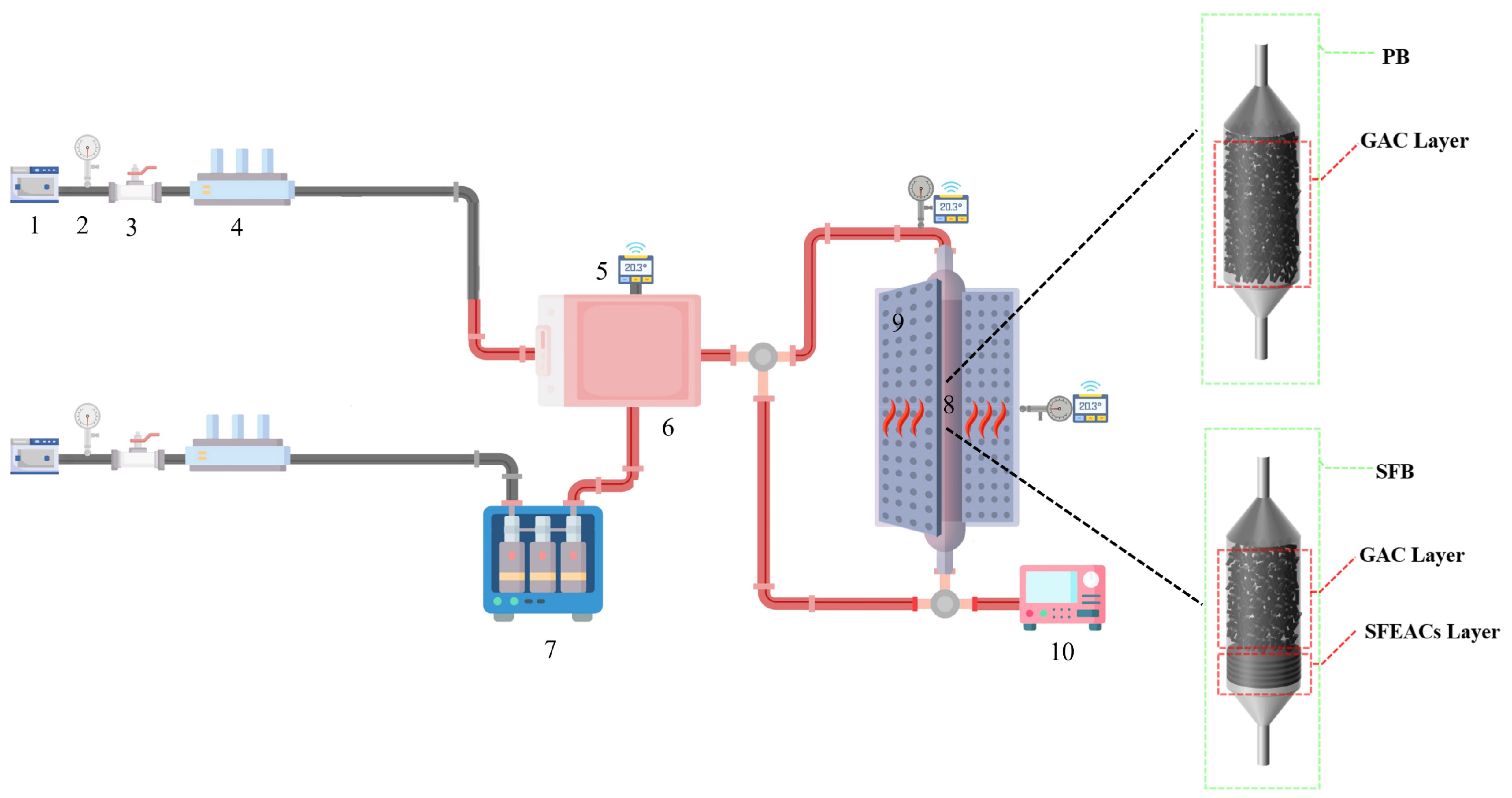
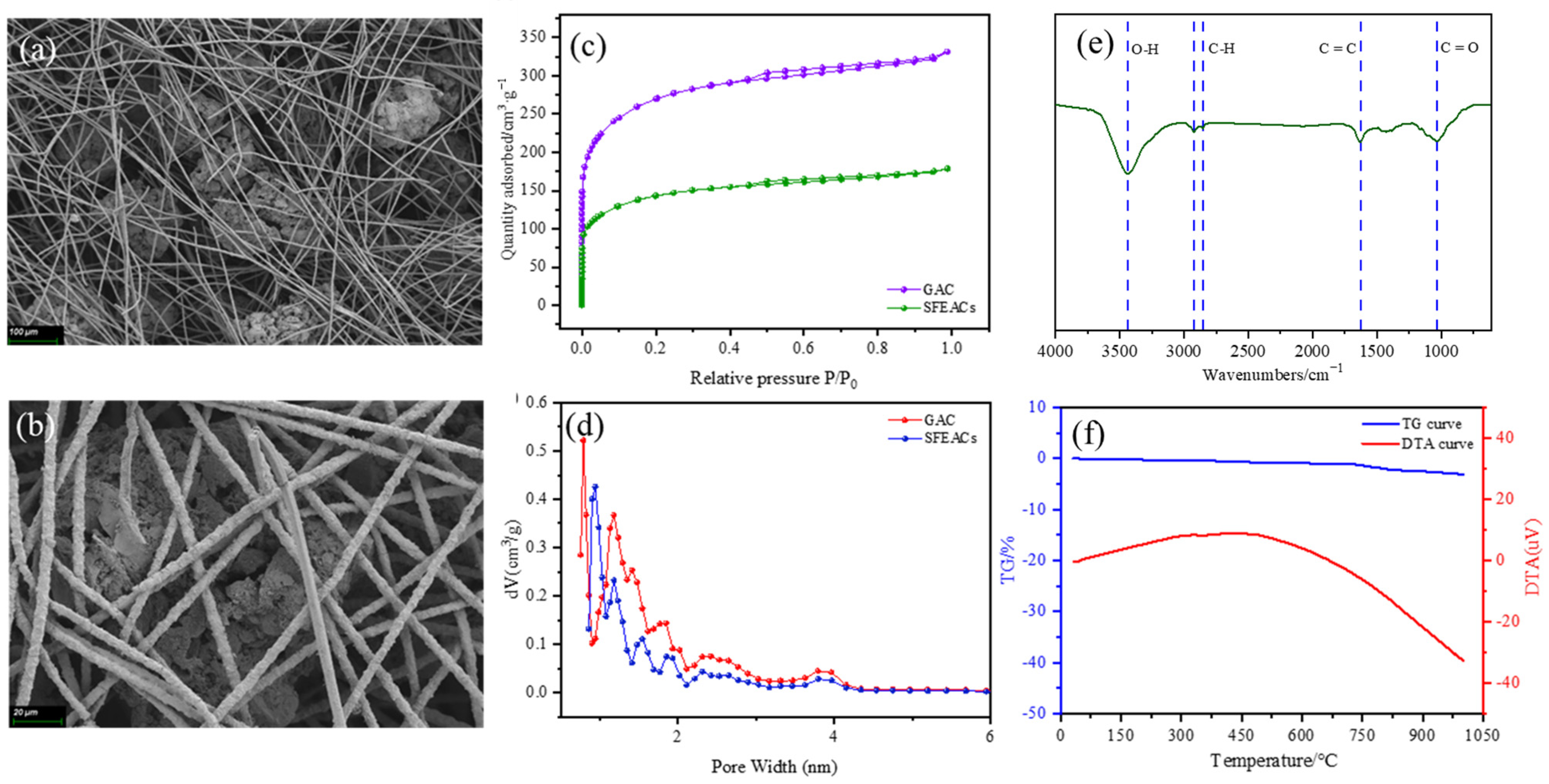

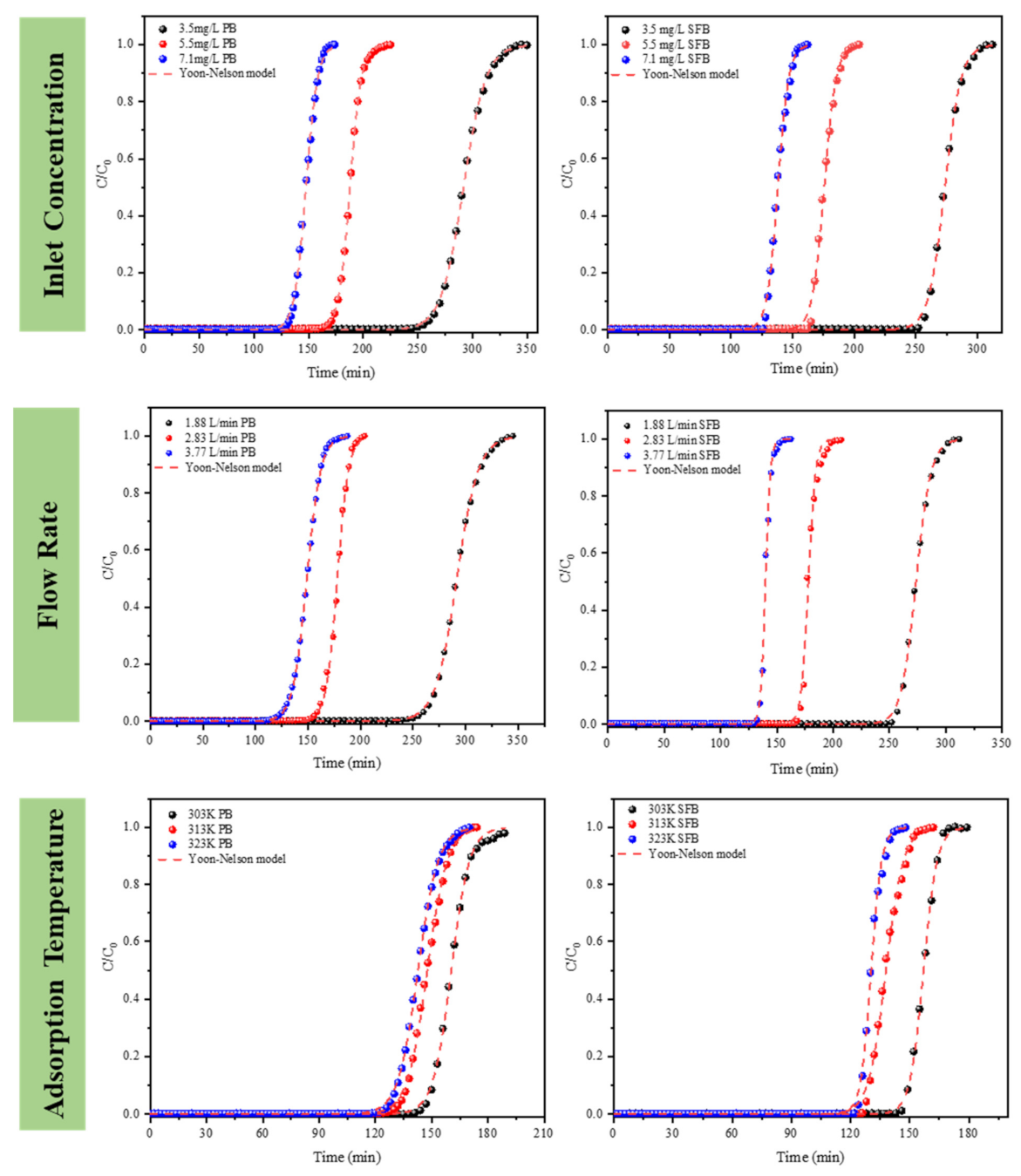
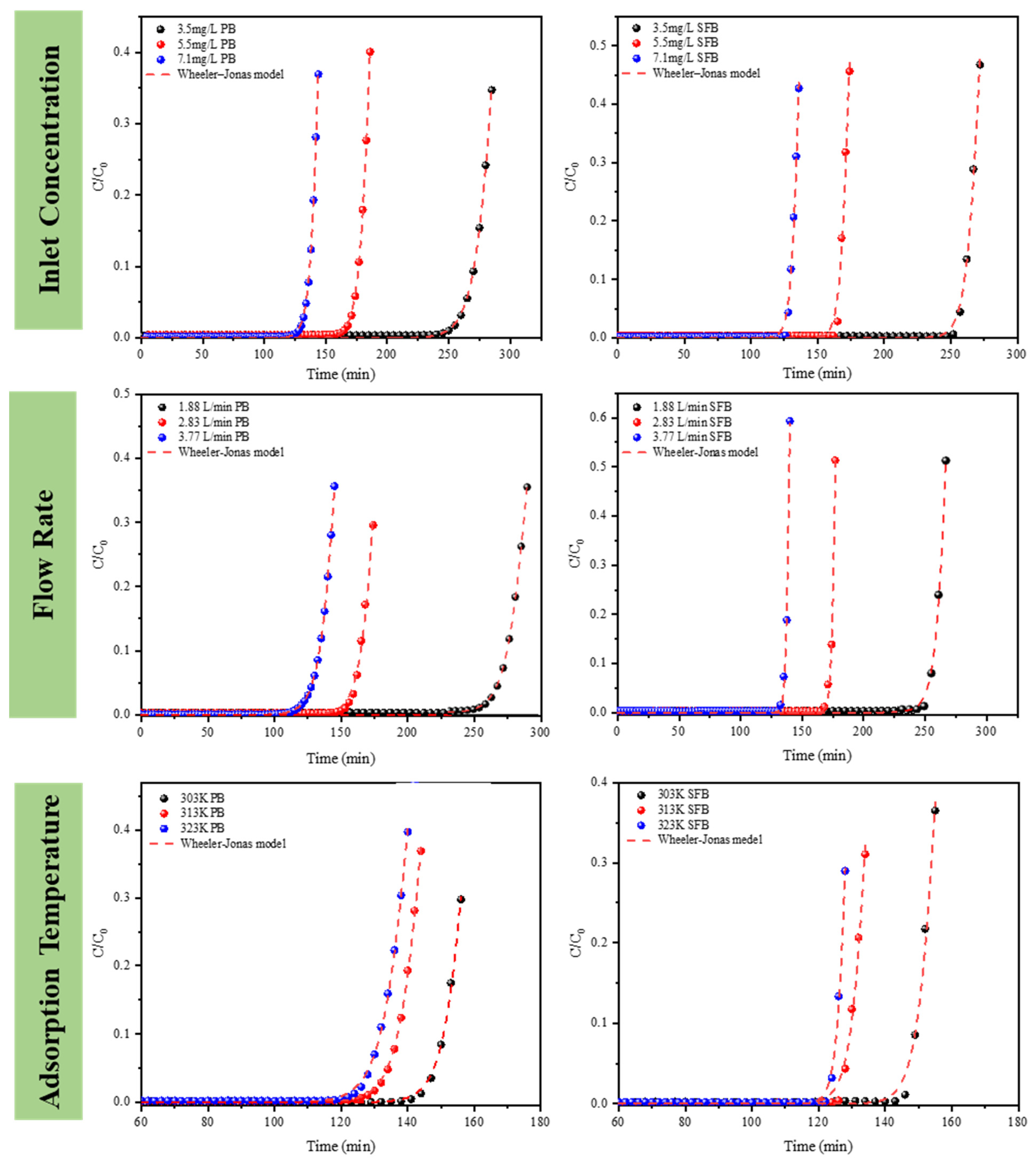
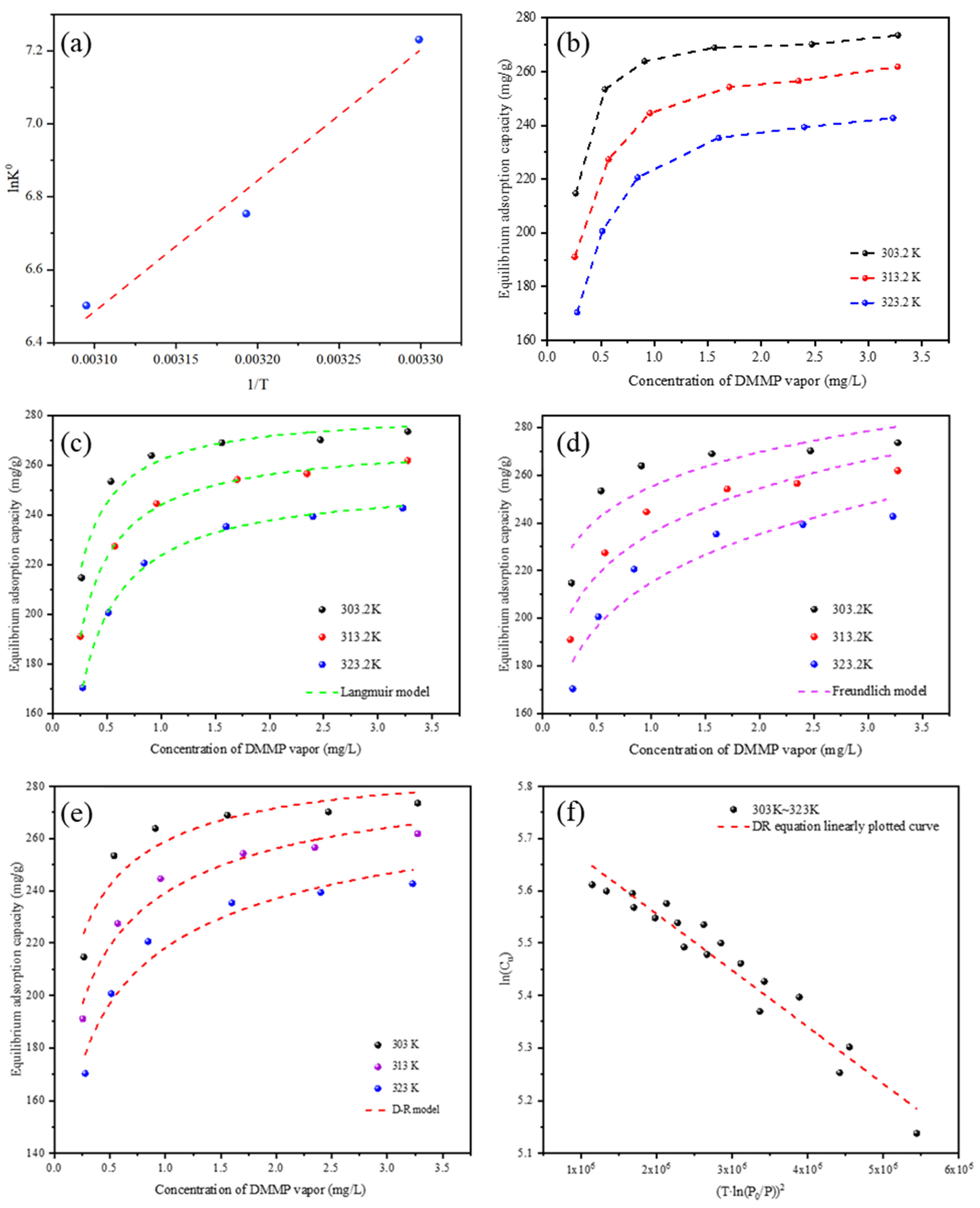
| Sample | SBET m2·g−1 | Vtot cm3·g−1 | Vm cm3·g−1 | Vmic/Vtot % | DAv nm |
|---|---|---|---|---|---|
| GAC | 982 | 0.5126 | 0.358 | 69.84 | 2.09 |
| SFEACs | 520 | 0.2764 | 0.188 | 68.02 | 2.13 |
| Bed | Conditions | τexp (min) | Yoon-Nelson | R2 | |||
|---|---|---|---|---|---|---|---|
| C0 (mg/L) | T (K) | Q (L/min) | τ (min) | k′ (min−1) | |||
| SFB | 3.6 | 313 | 1.88 | 273.9 | 273.5 | 0.15 | 0.9992 |
| 5.5 | 176.5 | 175.6 | 0.20 | 0.9979 | |||
| 7.1 | 138.3 | 138.0 | 0.23 | 0.9979 | |||
| PB | 3.6 | 292.5 | 291.8 | 0.10 | 0.9996 | ||
| 5.5 | 188.9 | 188.0 | 0.17 | 0.9998 | |||
| 7.1 | 148.3 | 147.7 | 0.19 | 0.9991 | |||
| SFB | 3.6 | 313 | 1.88 | 274.7 | 273.5 | 0.15 | 0.9992 |
| 2.83 | 179.7 | 178.0 | 0.31 | 0.9956 | |||
| 3.77 | 140.5 | 139.9 | 0.46 | 0.9977 | |||
| PB | 1.88 | 293.0 | 291.8 | 0.10 | 0.9996 | ||
| 2.83 | 192.5 | 193.1 | 0.14 | 0.9996 | |||
| 3.77 | 147.6 | 148.9 | 0.15 | 0.9999 | |||
| SFB | 7.1 | 303.2 | 1.88 | 157.8 | 157.0 | 0.30 | 0.9993 |
| 313.2 | 138.3 | 137.9 | 0.23 | 0.9979 | |||
| 323.2 | 131.2 | 130.5 | 0.37 | 0.9981 | |||
| PB | 303.2 | 160.2 | 160.4 | 0.21 | 0.9993 | ||
| 313.2 | 147.3 | 147.7 | 0.19 | 0.9991 | |||
| 323.2 | 143.6 | 142.7 | 0.19 | 0.9996 | |||
| Bed | Conditions | We (mg/g) | Kv (min–1) | Lc (cm) | tb (min) | R2 | ||
|---|---|---|---|---|---|---|---|---|
| C0 (mg/L) | T (K) | Q (L/min) | ||||||
| SFB | 3.6 | 313 | 1.88 | 397.4 | 10344.2 | 0.31 | 255 | 0.9979 |
| 5.5 | 395.9 | 7098.2 | 0.45 | 164 | 0.9980 | |||
| 7.1 | 401.4 | 6169.9 | 0.51 | 127 | 0.9992 | |||
| PB | 3.6 | 427.1 | 5550.6 | 0.57 | 249 | 0.9964 | ||
| 5.5 | 423.4 | 6117.8 | 0.52 | 159 | 0.9918 | |||
| 7.1 | 429.3 | 5396.5 | 0.59 | 121 | 0.9981 | |||
| SFB | 3.6 | 313 | 1.88 | 397.4 | 11027.2 | 0.29 | 255 | 0.9964 |
| 2.83 | 397.7 | 15360.4 | 0.31 | 165 | 0.9918 | |||
| 3.77 | 394.3 | 19641.3 | 0.34 | 132 | 0.9981 | |||
| PB | 1.88 | 427.4 | 5540.4 | 0.57 | 249 | 0.9978 | ||
| 2.83 | 427.2 | 7120.0 | 0.67 | 148 | 0.9999 | |||
| 3.77 | 429.3 | 8210.7 | 0.77 | 116 | 0.9964 | |||
| SFB | 7.1 | 303 | 1.88 | 456.9 | 8190.3 | 0.39 | 138 | 0.9993 |
| 313 | 396.1 | 7558.5 | 0.42 | 127 | 0.9979 | |||
| 323 | 345.2 | 7292.2 | 0.44 | 126 | 0.9980 | |||
| PB | 303 | 465.1 | 6550.7 | 0.48 | 136 | 0.9980 | ||
| 313 | 426.7 | 5609.2 | 0.57 | 121 | 0.9971 | |||
| 323 | 412.7 | 5307.2 | 0.60 | 116 | 0.9981 | |||
| (a) | ||||
|---|---|---|---|---|
| Models | Parameters | Temperature (K) | ||
| 303 | 313 | 323 | ||
| Langmuir | KL (m3/mg) | 13.25 | 9.56 | 7.47 |
| qe,cal (mg/g) | 281.9 | 269.7 | 253.7 | |
| qe,exp (mg/g) | 285.3 | 270.4 | 255.1 | |
| R2 | 0.964 | 0.998 | 0.998 | |
| Freundlich | KF (L/g) | 0.255 | 0.236 | 0.215 |
| 1/n | 0.079 | 0.112 | 0.130 | |
| R2 | 0.783 | 0.903 | 0.909 | |
| Dubinin-Radushkevich | q0,cal (mg/g) | 282.1 | 278.5 | 271.3 |
| qe,exp (mg/g) | 285.3 | 270.4 | 255.1 | |
| E (kJ/mol) | 17.70 | 17.87 | 18.75 | |
| R2 | 0.904 | 0.965 | 0.958 | |
| (b) | ||||
| T(K) | ∆H (kJ/mol) | ∆S (J/(mol·K)) | ∆G (kJ/mol) | |
| 303.15 | −23.33 | −15.52 | −18.63 | |
| 313.15 | −18.48 | |||
| 323.15 | −18.32 | |||
Disclaimer/Publisher’s Note: The statements, opinions and data contained in all publications are solely those of the individual author(s) and contributor(s) and not of MDPI and/or the editor(s). MDPI and/or the editor(s) disclaim responsibility for any injury to people or property resulting from any ideas, methods, instructions or products referred to in the content. |
© 2023 by the authors. Licensee MDPI, Basel, Switzerland. This article is an open access article distributed under the terms and conditions of the Creative Commons Attribution (CC BY) license (https://creativecommons.org/licenses/by/4.0/).
Share and Cite
Xie, Y.; Zheng, C.; Lan, L.; Song, H.; Kang, J.; Kang, K.; Bai, S. The Application of Microfibrous Entrapped Activated Carbon Composite Material for the Sarin Simulant Dimethyl Methylphosphonate Adsorption. Nanomaterials 2023, 13, 2661. https://doi.org/10.3390/nano13192661
Xie Y, Zheng C, Lan L, Song H, Kang J, Kang K, Bai S. The Application of Microfibrous Entrapped Activated Carbon Composite Material for the Sarin Simulant Dimethyl Methylphosphonate Adsorption. Nanomaterials. 2023; 13(19):2661. https://doi.org/10.3390/nano13192661
Chicago/Turabian StyleXie, Yucong, Chao Zheng, Liang Lan, Hua Song, Jian Kang, Kai Kang, and Shupei Bai. 2023. "The Application of Microfibrous Entrapped Activated Carbon Composite Material for the Sarin Simulant Dimethyl Methylphosphonate Adsorption" Nanomaterials 13, no. 19: 2661. https://doi.org/10.3390/nano13192661
APA StyleXie, Y., Zheng, C., Lan, L., Song, H., Kang, J., Kang, K., & Bai, S. (2023). The Application of Microfibrous Entrapped Activated Carbon Composite Material for the Sarin Simulant Dimethyl Methylphosphonate Adsorption. Nanomaterials, 13(19), 2661. https://doi.org/10.3390/nano13192661





